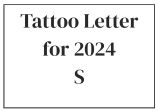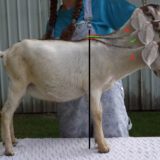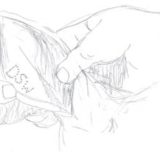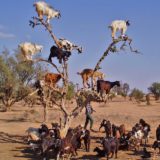What is a miniature dairy goat?
A first generation miniature dairy goat is the product of a standard-sized purebred/American goat bred to a Nigerian Dwarf. Only documented animals with traceable registrations may be used to produce a mini dairy goat registerable in the Experimental, American or Purebred herdbooks. Also, Nigerian Dwarves must be purebred and registered with one of the ND registries.
Further generations of miniature dairy goats are created by crossing minis with other minis. (See below for further information.) First and second generations of correct miniature goats are registered as “Experimental.” Third through fifth generations that meet the breed standards and the 70/30 rule are registered as “American.” Sixth generation, and beyond, are considered “Purebred” if they meet the breed standard
Why miniature dairy goats?
Breeders of standard dairy goats have been pushing for greater stature in these breeds for the show ring, resulting in many of the standard dairy goat breeds getting larger in recent years.
Additionally, some people with a small acreage are looking for a smaller milk-producing animal to provide a family milk supply. Some larger and smaller cities across the country now allow miniature dairy goats within city limits.
A mini dairy goat can often produce two-thirds the amount of milk that a standard dairy goat produces while consuming half as much feed, which could be helpful as the cost of feed rises. The influence of Nigerian Dwarf genetics may expand the breeding season past the fall months and also may increase the butterfat in the milk.
Children, seniors, and people with disabilities may find the mini breeds easier to handle. Hoof trimming, clipping, showing, and milking become much less of a challenge because of the minis’ smaller size. Also, smaller goats are in demand for the pet market.
What is the pedigree of miniature dairy goats?
Mini dairy goats are new breeds created by breeding a full-size dairy doe to a Nigerian Dwarf buck. The goal is to produce a mid-size dairy goat that, other than the smaller size, looks like the standard-sized breed.
Many people have been confused by the percentages listed on the pedigree. These percentages show the ratio of standard to Nigerian genetics in the mini dairy goat. Another common misunderstanding is the meaning of the “generation” of a mini dairy goat. Below is an attempt to explain where these percentages and terms come from.
Understanding Generations: A first generation (F1) is either a cross between a Nigerian Dwarf (ND) and a standard-sized doe (one of the recognized dairy breeds) OR a cross between a miniature dairy goat and a standard-sized goat, or Nigerian Dwarf. Any of these crosses result in a first-generation miniature dairy goat.
Breeding an F1 to another F1 creates a second generation (F2). F2 x F2 = F3, and so on. (Foundation animals [ND or standard breed] are considered 0 generation in the mini dairy goat herd book.) The generation of the kid is always one generation higher than the lowest generation of a parent. For example, if you breed an F3 to an F1, the kid is an F2. Even if you breed an F6 to an F1, the kid will only be an F2.
Figuring Percentages: Let’s say you’re breeding a 75/25 mini buck to a 62.50/37.50 mini doe.
Take the “standard” part of the percentage from both parents (75 and 62.50),
add them together (75 + 62.50 = 137.50), and divide the result by 2. That gives you 68.75, which is the percentage of standard genetics for the offspring. This is the first number shown in a percentage.
Next, to calculate the percentage of “Nigerian” genetics for the offspring, subtract 100 from 68.75 (the standard percentage you calculated earlier), which equals -31.25. This is the percentage of Nigerian genetics for the offspring, which is the second number shown in a percentage.
Consequently, the standard/Nigerian genetic percentages for kids of those parents will be 68.75/31.25.
Here is a pattern to follow for calculating percentages:
Sire: 75/25, Dam: 62.50/37.50
75 + 62.50 = 137.50
137.50 ÷ 2 = 68.75
68.75 - 100 = -31.25
Final result = 68.75/31.25
How much milk do miniature dairy goats produce?
Miniature dairy goats have been reported to produce anywhere from two lbs. (one quart) to ten lbs. (one-and-a-quarter gallons) daily, with the average production being around five to six lbs. (three quarts) of milk daily. However, genetics and management play important roles in milk production.
What if I want to experiment with percentages in my breeding program?
The purpose of MDGA is to provide you with an inclusive means of recording and supporting the development of miniature breeds. If you feel that you will better reach your goals by crossing your animals with percentages other than 50/50, MDGA will still register your goats. If, at any time you breed your animals back to a purebred Nigerian or a standard dairy goat, the offspring’s classification will revert back to first generation - "Experimental".
If you experiment with percentages as you develop your miniature dairy goat herd, it may take more generations for your animals to attain purebred status, but the results may be worth the extra time and effort.
How tall will the miniature dairy breeds be?
Miniature dairy goats are between the sizes of the Nigerian Dwarf and the standard breed.
NOTE: There is no longer a minimum height for miniature dairy goats, and the maximum height has changed.
Make Your Mini-Dairy Goat Herd Management Better & Easier!
Do you know what to expect from your animals?
Keep track of your herd’s pedigrees with MDGA’s registration services.
Are all your does pulling their weight around your farm?
Determine the contributions of each doe with milk testing services.
Does your mini dairy goat have correct conformation?
MDGA’s live and virtual shows can help you make better breeding plans for our herd by showing the conformational strengths and weaknesses of your goats.
Is it time for a new herd sire or doe?
MDGA’s breeder’s directory can help you find a breeder near you.







